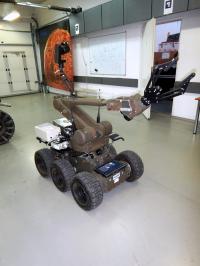Robot will detect biological weapons
Machines that replace humans in warfare is not just science-fiction anymore. The Warsaw University of Technology is participating in a project which makes this a reality.
The team led by Professor Tomasz Ciach from the Faculty of Chemical and Process Engineering has constructed a detector, thanks to which a remote-controlled robot can automatically detect dangerous bacteria in water and air samples. It is one of the elements of the project entitled “Mobile laboratory for taking samples and identification of biological threats” which is operated by the consortium led by the coordinator of the Military Institute of Hygiene and Epidemiology. The main aim was to create a laboratory which can be moved to the area where it is suspected that biological weapons might be used.
-The lab resembles a container and can be transported by a semi-trailer truck, explains Mr. Maciej Trzaskowski from Professor Tomasz Ciach’s team. Part of the equipment of this laboratory is a robot called Automatic Mobile Platform for Sample-taking & analyzing (MAPPI). It is a remote-controlled rover, which can be sent outside from a lab in order to take samples. These can be transported back to the lab, where they will be analyzed by the researchers, he adds.
The robot has its own detectors which analyze samples so we can instantly find out what kind of hazard is in the air. The team directed by Professor Tomasz Ciach from the Department of Biotechnology and Bioprocessor Engineering at WUT’s Faculty of Chemical and Process Engineering has made one of these detectors. It has microchips designed for Surface Plasmon Resonance(SPR) research. Special antibodies which react with particular groups of bacteria are connected to it. A sample is passed to a tank with a metering system. It has to be a liquid sample taken directly from a reservoir or it has to be a liquefied aerosol. The next step is to start the process of detection with the SPR detector.
- The detector automatically lets the sample flow through its system which has the microchips with antibodies. If the sample contains any of the bacteria, it will connect with the antibodies from the surface of the microchip and produce a measurable signal. The detector will send the information via the robot’s transmitter. The whole detection process takes about 20 minutes, says Mr. Maciej Trzaskowski.
The mobile laboratory is a unique solution on a European scale. Projects done by western companies up till now have not enabled an automatic detection process. However, samples taken by a robot have to be analysed once again in the laboratory in order to confirm the presence of contaminating substances and for more detailed analyses. The lab is designed in such a way so that a human has the least possible contact with contaminated samples, but yet his presence is necessary due to the procedures required for sample analysis.
The detector built by the team of Professor Ciach can detect any typical factors considered to be used as biological weapons ie. Bacteria of bubonic plague, cholera, anthrax spores, botulinum toxin etc.
The 'Mobile laboratory for taking samples and identification of biological threats' project received a prestigious award at the Targi Kielce's International Defence Industry Exhibition 2014 and a Golden Innovations Laurel 2014 awarded by the Polish Federation of Engineering Associations.
The WUT team is currently working on civilian use of the SPR detector. Enriched by the experience gained during the design process of the device, together with prof. Ciach, we want to make a new version which would analyse the samples and detect other kinds of bacteria, announced Mr. Maciej Trzaskowski.
___________________________
Faculty of Chemical and Process Engineering of WUT
“Mobile laboratory for taking samples and identification of biological threats”
Consortium members:
the Military Institute of Hygiene and Epidemiology, Military Institute of Armoured Vehicles and Technology, Military Technical Academy- Faculty of Mechanical Engineering, Military Technical Academy- Institute of Optoelectronics, Military Institute of Chemistry and Radiometry at the Adam Mickiewicz’s University, Wrocław University of Technology, Warsaw University of Technology, Industrial Research Institute for Automation and Measurements (PIAP), Hydromega Ltd., A&A Biotechnology s.c. Adam Burkiewicz, Mikołaj Burkiewicz, Krzysztof Kucharczyk Techniki Elektroforetyczne Ltd.







